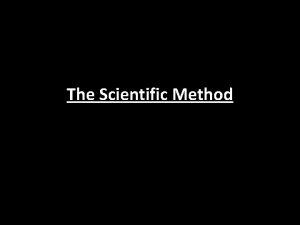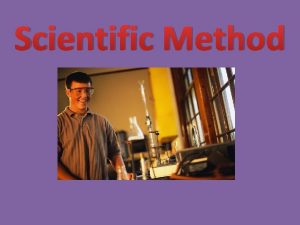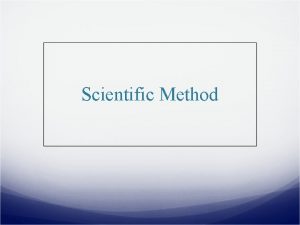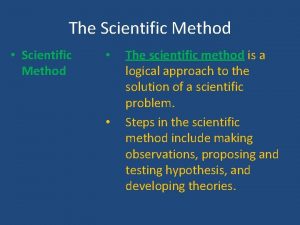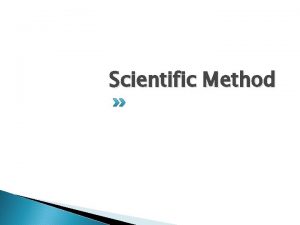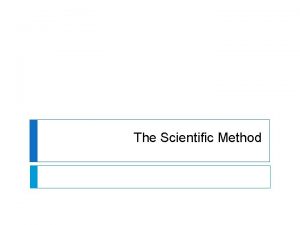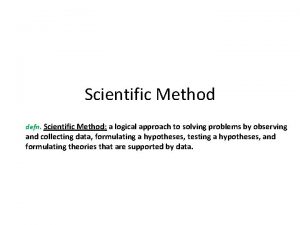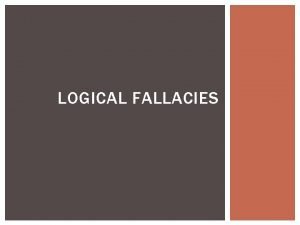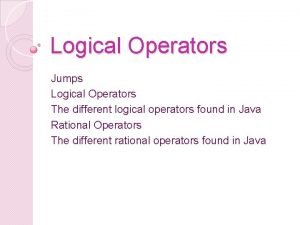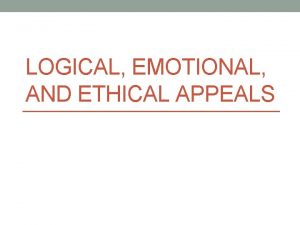Scientific Method The scientific method is a logical


















- Slides: 18

Scientific Method

The scientific method is a logical, systematic approach to the solution of a scientific problem. 1. Make an observation A. Qualitative-use your senses B. Quantitative-make a measurement 2. Leads to a Question 3. Hypothesis-proposed explanation for an observation.

4. Perform an Experiment **Design a procedure to test 1 variable There are 2 Types of Variables: A. Manipulated/Independent variable: The variable that will be manipulated B. Observed/Dependent variable: The variable that will change depending on the independent variable. **In order for results to be accepted, anyone must be able to repeat experiment with the same results.

5. Analyze Results If your results prove your hypothesis, then a theory can be developed. If your results do not prove your hypothesis, then return to step 3. (Propose a new hypothesis)

Theory vs. Law Theory: a well tested explanation for a broad set of observations. **Theories can never be proved-means that there is room for it to be changed. Law: Statement that summarizes many observations or experiments.

Theory or Law? 1. 2. 3. 4. 5. 6. Pressure is caused by particles moving very fast. Theory Atoms combine because of charged particles. Theory Compounds have a definite composition. Law Total mass is the same before and after a reaction. Law Light is caused by energy being Theory released in the form of waves. Heat flows from hot areas to cold areas. Law

Ms. G wants to find out which bug spray works best: Off, Avon, or Cutter. What should be kept constant (the same) over the course of the experiment?

These are the results: Group 1 2 3 4 (OFF): (Avon): (Cutter): (None): 4 mosquito bites 18 mosquito bites 10 mosquito bites 28 mosquito bites

Which group was the control? ◦ Group 4 What is the independent variable? (what did I change each time? ) ◦ Brand of Bug spray What is the dependent variable? (what changed because of the type of spray used? ◦ Number of Mosquito bites What should be her conclusion? ◦ OFF Brand is the most effective in reducing the number of mosquito bites.

Scenario #1: You read in the paper that the number of dead tadpoles along the Yadkin River has increased over the past few years. Since you are an inquisitive teen you want to know why. After examining all of the data available in the library, you decide to go with a hypothesis that increased Ultraviolet (UV) radiation from the deterioration of the ozone is killing off the tadpoles.

1. How many steps in the scientific method have been accomplished? Identify them. A. B. C. Make an Observation-decreased number of tadpoles. Ask a Question-What is killing the tadpoles. Hypothesis-UV radiation from the hole in the ozone layer is killing off the tadpoles.

You design an experiment with two groups of tadpoles. Group 1 has 100 tadpoles in a 5 gallon drum of water covered by a piece of glass. You read at the library that glass filters out UV radiation so that none will reach the interior of the container. The second group is set up exactly like Group 1 except it has acrylic plexiglass, which will not filter UV radiation out. You place the groups outside for a month with a regular feeding schedule and then observe the results.

2. What is the independent variable and what is the dependent variable? Independentexposure to UV light 3. Dependent-number of dead tadpoles Which is the control group? Group 1 -no UV radiation 2. What is the difference between the two groups? Exposure to UV radiation 3. What other factors have you attempted to control with this experimental setup? Size of container, number of tadpoles, water, food, temperature, time of experiment

Initial number of tadpoles Final number of tadpoles Group 1 100 Group 2 100 96 95 6. Does the information from this experiment support the hypothesis? No-the data doesn’t show any change. 7. If no, then what might be causing a decrease in the tadpole population? What do you think?

Scientific Method Activity The idea of science is built on evidence that can be observed or deduced from the natural world. We gather evidence through the use of our senses. However; the evidence can be confusing. Data (evidence) is not always consistent or available, so this is why scientific explanations are “tentative” explanations of natural phenomena. In this activity, you will be provided with many clues that may be used to develop an explanation (hypothesis).

Check Lab Scenario There used to be a family that lived in a house on 1065 Missing Lane. No one has seen them in over a month, and your detectives must figure out what happened to them. These envelopes contain a bunch of checks found in diffferent drawers inside of their home. You must collaborate within and outside of your groups to solve this mystery. You will see that as you acquire more evidence, it will change your hypothesis.

Checks Lab Instructions 1. 2. 3. 4. 5. 6. 7. 8. Students will separate into groups of 4. Each group of 4 will receive an envelope. Open your group envelope and randomly take out 4 checks without looking at them. Use the evidence from the checks to develop a hypothesis for what you think happened with this family. Open your envelope and remove four more checks. Construct a new hypothesis Now, remove the last 2 checks and modify your hypothesis for the last time. You should have 6 remaining checks in your envelopes, which you MAY NOT look at. Collaborate with the other groups to see if you can agree on a hypothesis as a class.

DISCUSSION QUESTION Which steps of the scientific method did you use in the Mystery Checks Activity? Which steps of the scientific method did you not use in the Mystery Checks Activity? Did you have to modify your original hypothesis? How many times? What caused that modification? Did you at any point allow your personal biases to influence your hypothesis?
 Exclusive or logical equivalence
Exclusive or logical equivalence Equivalence statement definition
Equivalence statement definition Scientific inquiry vs scientific method
Scientific inquiry vs scientific method Hình ảnh bộ gõ cơ thể búng tay
Hình ảnh bộ gõ cơ thể búng tay Lp html
Lp html Bổ thể
Bổ thể Tỉ lệ cơ thể trẻ em
Tỉ lệ cơ thể trẻ em Voi kéo gỗ như thế nào
Voi kéo gỗ như thế nào Tư thế worm breton
Tư thế worm breton Hát lên người ơi
Hát lên người ơi Môn thể thao bắt đầu bằng từ chạy
Môn thể thao bắt đầu bằng từ chạy Thế nào là hệ số cao nhất
Thế nào là hệ số cao nhất Các châu lục và đại dương trên thế giới
Các châu lục và đại dương trên thế giới Công thức tính thế năng
Công thức tính thế năng Trời xanh đây là của chúng ta thể thơ
Trời xanh đây là của chúng ta thể thơ Cách giải mật thư tọa độ
Cách giải mật thư tọa độ Làm thế nào để 102-1=99
Làm thế nào để 102-1=99 độ dài liên kết
độ dài liên kết Các châu lục và đại dương trên thế giới
Các châu lục và đại dương trên thế giới






















